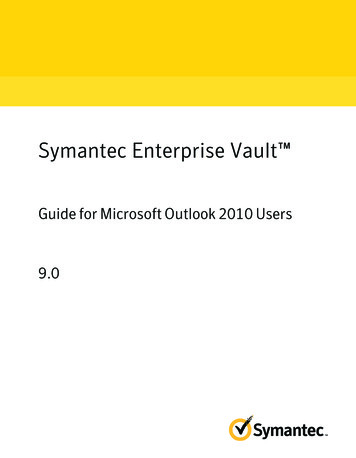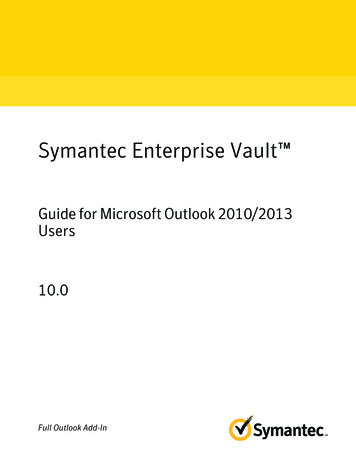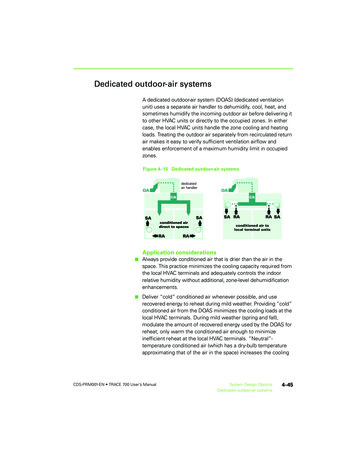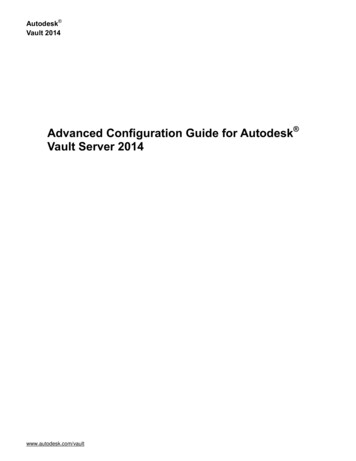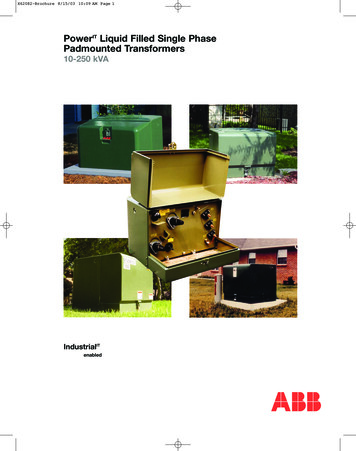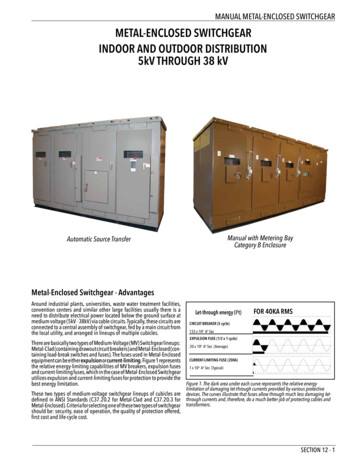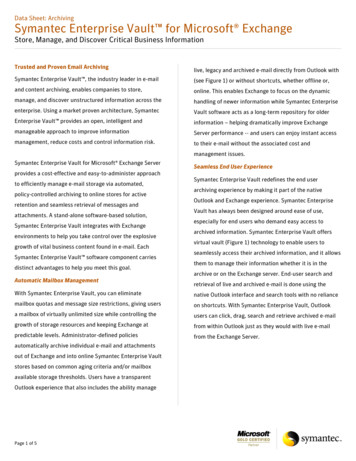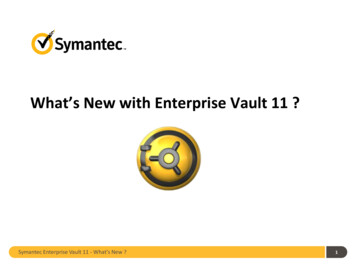
Transcription
SUPPLEMENT TOSPECIFICATIONS FORELECTRICAL INSTALLATIONSOUTDOOR PADMOUNTEDOR VAULT ENCLOSEDTHREE PHASE TRANSFORMERTHIS SUPPLEMENTAL BULLETIN IS SUPERCEDEDBY ESB 759B WITH THE EXCEPTION OF THOSESECTIONS NOTED WITHINELECTRIC SYSTEM BULLETIN No. 754/759October 2007(Supersedes issue dated December 2004.)ESB 754759 DRAFTrev10 17 2007.doc/SEIC
TABLE OF CONTENTSSection1.0PageINTRODUCTION.41.1PURPOSE .41.2SCOPE .41.2.1 Provisions .41.2.2 Additional Customer Provisions .51.3CODES AND STANDARDS.51.4COMPLIANCE .51.4.1 Preliminary Design.51.4.2 Construction Design .62.0DEFINITIONS .63.0GENERAL .63.14.0SERVICE VOLTAGE AND MAXIMUM TRANSFORMER SIZE: .6SERVICE CONNECTIONS .74.1HANDHOLES: .74.2MANHOLES: .74.3PRIMARY RISER POLE: .84.4CUSTOMER'S SECONDARY CONDUIT AND CABLE SYSTEM .84.4.1 Padmounted Transformer .84.4.2 Vault Transformer – Utilizing Single Phase Transformers .84.4.3 Terminations for padmount and single phase transformers .95.0TRANSFORMER INSTALLATIONS ON CUSTOMER PREMISES.95.1PADMOUNT TRANSFORMER LOCATION .95.2PADMOUNT TRANSFORMER FOUNDATION .115.3VAULT TRANSFORMER LOCATION, DESIGN AND CONSTRUCTION .115.3.1 General .115.3.2 Vault Design and Location .125.3.3 Vault Construction.125.3.4 Vault Maintenance.145.4SERVICE OPERATING PROCEDURES.146.0GROUNDING.156.1PADMOUNTED GROUND GRID INSTALLATION.156.2VAULT GROUND GRID INSTALLATION .156.3GROUND GRID RESISTANCE FOR INSTALLATIONS SUPPLIED FROM DELTA 2.4KV, 4.8KV, 12KV AND ALL23KV AND 34.5KV SYSTEMS .156.4GROUND GRID RESISTANCE FOR INSTALLATIONS SUPPLIED FROM WYE 5KV CLASS AND 15KV CLASSSYSTEMS .166.5GROUND GRID INTEGRITY .167.0CUSTOMER’S SERVICE EQUIPMENT AND COMPANY METERING.168.0PRE-ENERGIZATION REQUIREMENTS .16October 20072ESB 754/759
TABLE OF CONTENTS (cont'd)List of FiguresFIGURE 1Service Installation Diagram – Three Phase Padmounted TransformerFIGURE 2Three Phase Padmounted Transformer Required ClearancesFIGURE 3Grounding Plan - Three-Phase Padmounted TransformerFIGURE 4Oil Containment Curb (If Required)FIGURE 5Typical Transformer Concrete Pad DimensionsFIGURE 6Reinforced Concrete Flat Pad Three-Phase, ReinforcingSchedule)FIGURE 7Typical Above Grade Transformer VaultCustomer’s Three Phase Service Less Than 600 VoltsFIGURE 8Typical Above Grade Transformer Vault With Padmounted TransformerCustomer’s Three Phase Service Less Than 600 VoltsFIGURE 9Secondary Connections to Padmounted TransformersFIGURE 10Typical Primary Cable Handhole ConstructionFIGURE 11Typical Manhole RequirementsFIGURE 12Typical Primary Riser Pole DetailFIGURE 13Typical Trench DetailsFIGURE 14Transformer Installation ChecklistsESB 754/7593October 2007
1.01.1INTRODUCTIONPurposeLAN COD NTSU F EIPE GU NTR RE EXSE S CD 7 EPED & T8BY H SEAES V CTB E B ION75 E9B EN 5.3This Supplement to Electric System Bulletin (ESB) #750 provides specific guidance forCustomers whose service point is the secondary side of a Company owned transformer located onCustomer owned or controlled property.This supplement applies where the Company’s underground service lateral cable taps a primarydistribution or sub-transmission supply facility (that can be either overhead or underground innature) to feed a Company owned outdoor three phase pad-mounted transformer, ortransformer(s) located within a vault. It does not apply in a network area, or in URD / UCDareas.These requirements are to ensure that the electric facilities will render satisfactory service to theCustomer, and will not interfere with the electric supply to others served by the Company'ssystem.It is important that the Customer and their engineer or contractor obtain and refer to theSpecifications for Electrical Installations book (ESB #750) in conjunction with this supplementfor these installations.Installations requiring dual supplies, switching and protection at the transformer, dual primaryvoltage transformer, or multiple transformers shall be referred to the Company’s EngineeringDepartment for specific recommendations and approval.In response to the Customer’s written proposal, the Company will make the final determination asto the size, type, and location of the transformer used to provide service under this bulletin.1.2ScopeThese requirements concern only those points in which the Customer, their Consulting Engineer,Electrical Contractor, Equipment Manufacturer, and the Company have a mutual interest. Thisbulletin does not cover the Customer’s complete electrical installation design.1.2.1ProvisionsThe installation provisions and costs shall be in accordance with the Company's filed tariffs in theapplicable State.ALStateMA&RINHOctober 2007Company furnishes,installs, owns and providesmaintenance for:Customer furnishes, installs, owns and providesmaintenance for: an outdoor padmountedtransformer property on which to construct the transformerfoundation primary cable transformer pad foundation where required, the primary conduit system* [it isrecommended that spare conduit be installed] backfill all trenching and excavations after primarycable installation bollards, if required by the Company an outdoor padmountedground gridprimary cable trenchoutdoor padmounted transformer foundationexcavationproperty on which to construct the transformer4ESB 754/759
StateCompany furnishes,installs, owns and providesmaintenance for:transformerCustomer furnishes, installs, owns and providesmaintenance for:foundation primary cable trenchprimary cableLAN COD NTSU F EIPE GU NTR RE EXSE S CD 7 EPED & T8BY H SEAES V CTB E B ION75 E9B EN 5.3outdoor padmounted transformer foundationexcavationNY an outdoor padmountedtransformer primary cable andterminations transformer pad foundation backfill all trenching and excavations after primarycable installation bollards, if required by the Company primary cable trench transformer pad foundation backfill all trenching and excavations after primarycable installation bollards, if required by the Companyground gridwhere required, the primary conduit system [it isrecommended that spare conduit be installed]property on which to construct the transformerfoundationoutdoor padmounted transformer foundationexcavationground gridwhere required, the primary conduit system [it isrecommended that spare conduit be installed]* Ownership transfer to Company after initial installation for operation and maintenance.1.2.2Additional Customer ProvisionsThe Customer shall furnish, install, own, and maintain the complete low voltage serviceconnection from the transformer low voltage terminals, including conduit, cables, compressionconnectors, etc.AL1.3Codes and StandardsThe Customer's electric service equipment and its installation shall conform to the requirementsof the latest edition of the National Electrical Code (NEC), American National Standards Institute(ANSI), Insulated Cable Engineers Association (ICEA), National Electrical Manufacturer'sAssociation (NEMA), National Fire Protection Association (NFPA), all local ordinances, stateand local building codes and Company requirements and specifications.The Customer should consult their insurance carrier for any special safeguards which the carriermay require for the transformer and switchgear locations.1.41.4.1CompliancePreliminary DesignPrior to meeting with the Company, the Customer shall provide three (3) copies of an electricalsingle-line diagram and a fully dimensioned plot plan indicating property lines, building outlinesand detail of the preferred location for the electrical service equipment, transformer pad or vault,as well as the location of other buried facilities.ESB 754/7595October 2007
For a specific installation it is essential the Company meet with the Customer or theirrepresentative to mutually establish the arrangement and location of the proposed facilities.LAN COD NTSU F EIPE GU NTR RE EXSE S CD 7 EPED & T8BY H SEAES V CTB E B ION75 E9B EN 5.3As a result of this meeting, the Company will confirm the delivery voltage, specify thetransformer size and type based on the amount of capacity the Customer is currently requesting.In addition the Company will provide the short circuit interrupting duty that the Customer’sequipment shall be capable of interrupting based on Section 9 in ESB 750. The Customer isresponsible to ensure their service equipment will be satisfactory for the supply characteristics inaccordance with the NEC and sufficient for their future maximum demand.The information the Customers or their contractor furnishes the Company in regard to theCustomer's proposed electrical installation shall be in writing.If significant changes are made to the design or scheduling of the installation by the Customer,initial information furnished by the Company shall be subject to review and possiblemodification.1.4.2Construction DesignAfter the initial meeting, the Company will designate the pole, manhole, or switchgear fromwhich the primary cable will be extended including the route of the primary cable and locationsof handholes and manholes.The Company's Business Services or Distribution Design Department will advise the Customerconcerning any contribution required in accordance with the Company's filed tariff.THE CUSTOMER SHALL SUBMIT THEIR FINAL PLANS TO THE COMPANYBEFORE AWARDING CONTRACTS, ORDERING EQUIPMENT OR STARTINGWORK to ensure that the proposed design for the electric service installation conforms toCompany requirements. Three (3) copies of the following information shall be submitted to theCompany for its acceptance:2.01.Architectural drawings and specifications relating to the electric service equipment andtransformer pad location. Design drawings pertaining to a vault installation shall beuniformly prepared and sealed by the Customer’s design professional.2.Manufacturer's proposed specifications for the electrical service equipment.3.Manufacturer's approval assembly drawings relating to the physical arrangement of theelectrical service equipment including installation details for metering transformers.4.Electrical single-line diagram illustrating the service connection up to the main serviceequipment, metering, and any standby generation including transfer equipment.DEFINITIONSALNote: Definitions as used in this specification are provided in the "Specifications forElectrical Installations" book (ESB#750).3.0GENERAL3.1Service Voltage and Maximum Transformer Size:WiresDelivery Voltage44208 wye/120480 wye/277October 2007Transformer kVA LimitOutdoor Padmount Vault (3- 1 ph. transf.) Vault (padmount)1000100010002500150025006ESB 754/759
4.0SERVICE CONNECTIONS4.1Handholes:One or more masonry, or polymer concrete, handholes may be required to facilitate cable pullingor conduit drainage. Where splicing is necessary, handholes may be permitted for cables less than #4/0AWG. The minimum size of a handhole shall be 2-1/2 feet wide x 5 feet long x 3 feet deep, insidedimensions with a full length, two section split cover. Refer to Figure 10 for typical handholeconstruction. The design of the handhole shall be approved by the Company. The top of the handhole cover shall be at finished grade. All handholes, including covers, shall be capable of withstanding H-20 loading; however, these arenot meant for installation in streets and roadways. A pulling eye shall be installed on the short width wall and shall be 1-inch diameter eye bolt. Thepulling eye and wall shall be capable of 1,500 pounds pulling strength. The handhole floor shall be on a flat, #2 crushed stone base 4 inches thick. Conduits shall enter the handhole directly opposite each other on the smaller end walls. Conduit bells shall be installed on each conduit. The centerline of the conduit in the handhole shall be approximately 6 inches from the 5 foot walland 15 inches above the floor. If metallic conduit is used, a #2 CU ground grid shall be installed to allow for the bonding ofthe conduit. Conduit shall be bonded together with a #4 Cu (solid) to the ground grid. Where splicing is necessary for one set of #4/0AWG cables, a heavy duty handhole may beused per Figure 10. For multiple sets of #4/0AWG cables, or cables larger than #4/0AWG amanhole shall be used.LAN COD NTSU F EIPE GU NTR RE EXSE S CD 7 EPED & T8BY H SEAES V CTB E B ION75 E9B EN 5.3 AL4.2Manholes: One or more masonry or concrete manholes may be required to facilitate cable pulling or conduitdrainage. The design of the manhole shall be approved by the Company; refer to Figure 11 forspecifications. All manholes shall have a 26-inch manhole cover with a 36-inch minimum cast iron frame,designed for AASHO-HS20-44 direct wheel loading and 26-inch to 36-inch manhole ring asindicated in Figure 11. The top of the manhole cover shall be at finished grade. All manholes, including covers, shall be capable of withstanding AASHO-HS20-44 direct wheelloading. A 4/0 AWG, 19 strand soft drawn ground grid shall be installed in the manhole. If metallic conduit is used, conduit shall be bonded together with a #4 Cu (solid ) to the groundgridESB 754/7597October 2007
4.3Primary Riser Pole:The Customer shall install a rigid galvanized steel conduit and a rigid galvanized steel sweep on theCompany’s primary cable riser pole. For riser conduit installation details, see Figure 12 of thisbulletin and refer to Section 4.3.2 and Table 5 “Primary Conduit Sizes” of ESB 750.4.4Customer's Secondary Conduit and Cable SystemPadmounted TransformerLAN COD NTSU F EIPE GU NTR RE EXSE S CD 7 EPED & T8BY H SEAES V CTB E B ION75 E9B EN 5.34.4.1 Customer’s conduits shall be terminated at the equipment pad at the locations shown in Figure 6. The Company's transformer will be equipped with bushings that accept NEMA standard two-holespade terminals mounted in the secondary compartment. Size and number of customer’s secondary cables (service entrance conductors) shall be inaccordance with the NEC and shall be approved by the Authority Having Jurisdiction (AHJ). The Customer-owned secondary conductors shall be insulated, stranded cable up to the maximumnumber listed below (number of conductors/phase and neutral):Transformer 75oCSpade Terminal4 Hole Spades6 Hole Spades10 Hole SpadesTransformer ApplicationkVA RatingL.V. Rating75 – 300208Y/12075 – 500480Y/277500750 – 1500750 – 1000208Y/120480Y/277208Y/1202000 – 2500480Y/277MaximumSecondary Conductor Sets and Size6 sets 750 kcmil8 sets 750 kcmil10 sets 600 kcmil or 8 sets of 750 kcmilDetails of the Company’s transformer spade terminals are shown in Figure 9. If a Customer requires more cables or the total circuit exposure exceeds 1000 feet, the Customershall provide suitable service equipment adjacent to the padmount transformer.1. This equipment shall consist of an outdoor cubicle with bus of a capacity to meet thetransformer load and braced for the short circuit capacity.2. Each cable leaving this device shall have overcurrent protection.3. The service equipment shall be approved by the Company prior to fabrication.AL 4.4.2The neutral bushing of the transformer shall be connected by the Customer with full size neutralconductor(s) and grounded to the pad ground.Vault Transformer – Utilizing Single Phase Transformers Bus duct is recommended for the connection between the transformer secondary terminals in thevault and the service equipment in the electric room. The bus duct enclosure shall be electricallycontinuous to the service equipment enclosure. The leads which connect the secondary bus to the transformer terminals shall be insulatedstranded copper cable not smaller than the size listed in the National Electrical Code for “Singleconductor in free air” for the current to be conducted when the transformer is carrying its ratedkVA load. The neutral bushing of each transformer within a vault shall be connected by the Customer with afull size neutral conductor(s) external of the bus duct and grounded to the vault ground.October 20078ESB 754/759
4.4.3Terminations for padmount and single phase transformers All secondary connectors and connector fasteners shall be furnished, installed, owned andmaintained by the Customer. Secondary connectors shall be listed for the purpose according to the NEC and meet the Company’srequirements in Section 4.4.1 above and as follows.LAN COD NTSU F EIPE GU NTR RE EXSE S CD 7 EPED & T8BY H SEAES V CTB E B ION75 E9B EN 5.31. Minimum secondary conductor connector thickness shall be ¼ inch, with 9/16 inchdiameter holes. Aluminum connectors shall be used with aluminum cable and bronzeconnectors shall be used with copper cable. Tin plated connectors can also be used as analternate for aluminum and bronze connectors.2. Connector shall be a cable to flat clamp or compression type connector, with a minimum oftwo holes in the flat pad and two clamping elements or two compressions per cable. Secondary connector fasteners for use at the transformer terminals shall be stainless steel and listedfor the purpose according to the NEC. Final torque tightening of the secondary connectors shall be completed by the customer. The Customer shall provide the Company with a written report of satisfactory installation acceptancetests of their service cables and connections to the secondary terminals of the Company’s transformerprior to energization. See Checklists in Figure 14. The exposed live parts of the secondary connections may be required to be covered with electricaltape (or equivalent), by the customer, if deemed necessary by the company, to a thickness not lessthan 1/16 inch, where between live parts and live part-to-ground spacing has been compromised.5.0 TRANSFORMER INSTALLATIONS ON CUSTOMER PREMISES[Excluding Underground Residential/Commercial Distribution (URD/UCD)]5.1Padmount Transformer LocationALGeneral: The Company will endeavor to work with the Customer to determine a mutuallysatisfactory location of the Company’s transformer; however, the final location of thetransformer shall be at the sole discretion of the Company. Where sufficient property exists, space separation shall always be used as the primarysafeguard method to comply with Rule 152A of the NESC regarding therequirements of outdoor installed liquid-filled transformers. In no instance, will theCompany rely on automatic extinguishing systems for installations on privateproperty. As the Company’s service point is the secondary terminals of the transformer, thetransformer should be located as close as possible to the Customer’s load center.Proximity to Buildings:The clearances to buildings and property lines shown in Figure 2 are chosen to achieve thenecessary space separations for oil-insulated transformers installed outdoors in accordancewith good utility practice. Where these space separations can not be achieved, additionalsafeguard methods such as oil containment and absorption systems, fire-resistant barriers,etc. may be considered by the Company if first approved in writing by the appropriate localauthority having jurisdiction over fire prevention. In extreme cases, the transformer mayneed to be installed in a vault. To ensure the Company has adequate access to thetransformer, under no circumstances will clearances be reduced to less than five (5) feetfrom the edge of the transformer pad or three (3) feet from the inside edge of the transformerESB 754/7599October 2007
oil containment curb where used to the sides of the transformer. The minimum distancefor the front of the transformer must be at least 10 feet. Clearances shall be measured from inside edge of transformer oil containment curbwhere oil containment is required. If the building has an overhang the distance to the inner edge of the transformer oilcontainment shall be measured horizontally from the outer edge of the overhang.LAN COD NTSU F EIPE GU NTR RE EXSE S CD 7 EPED & T8BY H SEAES V CTB E B ION75 E9B EN 5.3Proximity to Above Grade Facilities:A horizontal clearance measuring ten (10) feet from the edge of the transformer pad shall bemaintained to the closest point of all fire hydrants, cell towers, or other foreign objects.A horizontal clearance measuring twenty-five (25) feet from the edge of the transformer pador the inner edge of the transformer oil containment where used shall be maintained to theclosest point of all above grade gas piping, fuel lines, and fuel storage tanks. Where thisclearance can not be achieved, an additional safeguard such as a fire-resistant barrier shall benecessary and be approved in writing by the Fire Protection Code AHJ and shall not be lessthan five (5) feet from the edge of the transformer pad.Proximity to Buried Facilities:An area measuring ten (10) feet from the edge of the transformer pad or each inner edge ofthe transformer oil containment where used shall be maintained to the closest point of allburied waterlines, gas lines, sewer lines, communications circuits, other electric lines,storage tanks, etc.Vehicular Traffic:The Company will determine when bollards are required to protect transformer installationsthat may be exposed to vehicular traffic, grass cutting, or snow plowing equipment.Any bollards that are required shall be provided and installed by the Customer as specifiedin Figure 2.ALTransformer Oil:October 2007Transformer installations on premises are subject to Company, local, state, and federalenvironmental rules and regulations. Where the Customer chooses or if the transformerlocation is near an environmentally protected area or there is risk of fire spread in spacelimited locations the transformer shall have oil spill containment. See Figure 4 for oil spillcontainment construction and spacing requirements. The following are considerations forwhen oil spill containment is necessary: Project location in National or State parks. Environmental resources or sensitive areas such as, but not limited to:9 State or Federal regulated wetlands or adjacent areas as locally defined9 River, stream, lake, pond or other water resources (beds, banks or waters)9 Designated scenic highways or vistas9 State forestlands or wildlife management areas9 Other designated protection areas (nature preserves, refuges, parks, etc.)9 Contaminated sites, including hazardous, industrial or solid waste disposal sites9 Cultural Resources and state or federal historic preservation sites9 Endangered Species Any special environmental interest groups having jurisdiction over or an interest inthe project. In all cases, the company reserves the right to require oil containment.10ESB 754/759
LAN COD NTSU F EIPE GU NTR RE EXSE S CD 7 EPED & T8BY H SEAES V CTB E B ION75 E9B EN 5.3Where vandalism is a concern, galvanized steel grating should be used on the surface ofthe crushed stone. This grating shall be bonded in two places with #2 AWG solid copperwire to the transformer ground grid.Clear Working Area:A minimum of ten (10) feet clear working distance shall be maintained in front of the doorsfor operating and maintenance of the transformer.Bushes, trees, walls, fences, or other obstructions shall not be planted or installed in frontof the doors.The doors of padmounted transformers shall normally face the street.Accessibility:The transformer site shall always remain accessible to Company trucks equipped for theinstallation, removal and continued operation and maintenance of transformers.Access ways to transformer sites in grass areas require a solid, well-drained base underthe grass. The area should be capable of supporting trucks and equipment having amaximum bearing weight of 6,500 lb. per square foot without creating a depression ofmore than two (2) inches. If this criteria is not met by the Customer, appropriate fillmaterial or steel plating will be required, as determined by Company personnel, and theCustomer will be responsible for the cost of any such extra measures taken by theCompany.5.2Padmount Transformer Foundation1.The designs shown in Figure 5 are adequate for transformers up to 2500 kVA withoutprimary switching.2.For other cases the Company shall be consulted.3.The transformer foundation shall be installed in the following manner:a. Earth beneath the foundation shall be undisturbed or well tamped.b. Number 2 crushed stone shall be installed in six (6) inch well tamped layers.c. Concrete reinforcement shall be installed in accordance with the attached drawings.ALd. Concrete shall have a minimum strength of 5000 psi. Poured in place concrete shall be cured for 28 days. Alternatively, “High-Early” concrete shall be cured for 7 days.e. Precast foundations approved by the Company are acceptable.5.35.3.14.Setting of the Company’s transformer shall occur once the Customer’s concrete pad hasreached full strength. If the Customer requires the transformer set earlier but not less than 7days, the Customer takes the risk of damaging their pad and delaying service to make thenecessary replacement.5.The Customer shall provide the Company with a written report of satisfactory installation oftheir foundation for the Company’s transformer prior to energization. See Checklists inFigure 14.Vault Transformer Location, Design and ConstructionGeneralThis information describes the minimum structural, electrical, and mechanical requirements forthe installation of a transformer vault by the Customer on private property. It is not intended tobe a comprehensive document, and should be used only as a guide.ESB 754/75911October 2007
The vault shall be under the sole control of the Company and accessible to authorized Companyemployees at reasonable hours. No other persons shall be admitted to the vault after thetransformers have been energized.5.3.2Vault Design and LocationIt is the purpose of the transformer vault to isolate the transformers and other apparatus and toconfine any fire that might be caused by the failure of any of the apparatus. The design,con
Specifications for Electrical Installations book (ESB #750) in conjunction with this supplement for these installations. Installations requiring dual supplies, switching and protection at the transformer, dual primary voltage transformer, or multiple transformer
